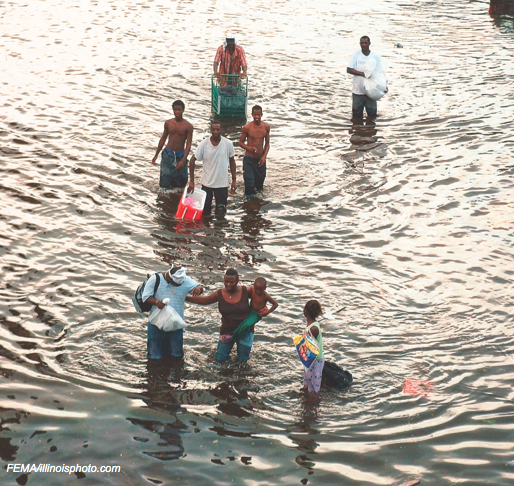Last week, we laid out out the case for nixing the polar bear as the face of climate disruption and put out a call for ideas and images on how to put a human face on the issue. Here is what Climate Access members and others had to say (and show).
Also see the guest blog post on the issue from Liz Banse of Resource Media.

Climate change will become real for most people in the way it changes weather and climate extremes. We may not be able to detect the mean temperature inching up, but we will notice more days of extreme heat, more floods and storms, more wildfires and droughts. The human face of climate change will very often be the same as the human face of these sorts of extreme events.
While it’s fairly easy to find photos of the impacts of extreme events on infrastructure and the landscape (e.g., buildings smashed by fallen trees, washed out roads, forests with only burnt stumps remaining), it’s much harder to find photos that capture the devastation they cause in real people’s lives (e.g., the families returning to witness their destroyed homes, people being evacuated). Extreme heat and more extreme allergies are affecting millions of people across the nation each year, yet very little has been done to put a human face on these climate impacts.
Even when we have these sorts of photos (e.g., see the collections of photos from Hurricanes Katrina, Rita, and Ike at www.illinoisphoto.com), we still often have a hesitancy to use them as examples of how climate change is affecting people. My sense is that this hesitancy stems partially from the fact that scientists have been cautious about attributing specific events to climate change, which is less and less of an issue as our understanding and attribution capabilities have improved. And, I think it stems partially from the anxiety associated with realizing that WE are these people. Climate change isn’t some problem that affects people far away or long into the future. If the heat exhaustion my grandma experienced is partially due to climate change, what does that say about my culpability as someone who still relies upon fossil fuels?
Finally, a big hurdle for putting a human face on climate change is not just finding the right images, but also finding the right messengers. As a scientist working on communicating climate change, I’d rather stay in my comfort zone of data, maps, and numbers. How much has the planet warmed so far, what might happen under different emissions scenarios, how many species could go extinct, etc. This rather clinical approach allows some emotional distance from what climate change means for people and the planet. I can only imagine that many other scientists engaged in climate communication feel similarly.
NWF has recently put out a couple reports featuring stories of impacts on real people that our field team gathered.

You asked for the new face of climate change. It’s kids: yours, mine, somebody else’s. Excellent example – look at the boy with the antlers.
If you don’t want to use kids plural, then shoot one little kid from behind. Same clothes, same kid, different scenes. Let folks fill in the face with their imagination. (they’ll almost always put in the face of a child they know.) But it’s all about kids.
By the way, polar bears was perhaps the worst idea ever. Why pick a symbol that only appeals to a tiny portion of the target demographic; something distant, something that has no connection to our everyday lives? Makes no sense. Same with some refugee fleeing a flood in Pakistan or a drought in Africa. Bring it home. Make it personal. Tie it directly to the American public in ways people can’t ignore. America’s climate kids. Damn, this stuff is 101. No wonder we haven’t been able to accomplish anything in DC.
Why try to reinvent the wheel? We’re screwing future generations. Let’s make it obvious, and personal. The answer to your question is kids.
Alan Honick, The Sense of Fairness
Babies are literally the future, and while climate change is possibly proceeding more quickly than anyone suspected, it’s still about the future. And it seems inappropriate to use a single face, a single race, since it’s about people all over the world. I like the idea that it’s not faces, but the anonymity and vulnerability of those baby backsides on the harsh cracked landscape, the hint that their faces are gazing off toward the uncertain horizon.
This is the best idea I could come up with on short notice. Not exactly faces, but there you go. At least they’re human.
Kat Friedrich, Science Is Everyone’s Story:
One angle that is becoming more and more effective is sea level rise. Sea level rise affects communities worldwide. For example, a news project in New York City could involve taking a video camera out into the streets, showing people maps of which parts of Manhattan will be flooded due to global warming, and asking them about their reactions. People often care about local and popular beaches; interviewing beachgoers would also be effective.
Talking about home repairs due to global warming would also be effective. When I lived in the Midwest, basement flooding was becoming increasingly common there.
Similarly, stories about Alaskan infrastructure being damaged due to permafrost changes would also have a local impact. Sea level rise damages infrastructure too, especially in low-lying areas such as New Orleans.
Global warming also affects prospects for hunting and fishing. In areas where hunting and fishing are popular or used for subsistence, a story about this could have a significant impact.
The main thing that isn’t working for me is a lack of well-correlated data. It’s relatively easy to attribute sea level rise to global warming; there are other things that are more erratic, such as weather and agricultural effects, which are more difficult to pin down in a cause-effect relationship.
D
When it comes down to it, I think people care the most about their health and the health of their children. They want to provide a safe, healthy space for future generations to live in, but especially for their next of kin. When we make a connection between climate disruption and the negative effect it has on our children’s health, people listen.

Our protective impulses are immensely powerful, and nothing arouses us like the honest efforts and struggles of those who are weaker.
I suggest this image of a Bangladesh mother and her two boys. Especially as Bangladesh has offered its widow’s mite to fighting climate change and promised to limit its carbon emissions – no caveats, ifs or buts.

Attached is a subset of slides from my most recent presentation about the impacts of climate change. Comments for each slide below:
1) This is the only image that belongs to me. These are my two young boys playing at the beach. I tell people that we escape to the beaches due to the heat waves caused by global warming but the sea is NOT our friend in the long term. This same global warming is likely to make hurricanes more intense with stronger flooding storm surges and that rising sea level is an equal opportunity disaster. The rising seas are unstoppable and they will impact you whether you are young or old, rich or poor, Democrat or Republican.
2) Everybody is nervous about flying at least a little. This one to demonstrate consensus and expertise has been very effective.
3) Adding 3 ppm CO2 to the air (6 ppm before sinks remove half) sounds non-threatening until the sheer mass of that CO2 is put in terms we can all appreciate – Gulf Oil spills.
4) Old and young health issues.
5 & 6) Few like biting bugs. The Brown Recluse image gets more reaction than any other slide.
7) Coffee prices usually get people’s attention.
8) For the college crowd: beer is taking a hit! (I always finish with this one at colleges.)

My top-of-mind answer is that Bill McKibben has become the face of climate change – the Noah of our day, as Rose Marie Berger put it in this post at Sojourners. Between his articles in Rolling Stone, the recent extended profile in Outside magazine, and the upcoming “Do the Math” tour, he seems to be everywhere. I take special interest in his success since he is, after all, a Sunday School teacher, but not one above dropping the f-bomb once in a while. We have other people of faith who are strong spokespeople on climate — including my boss, The Rev. Canon Sally G. Bingham — but no one else in the entire environmental community has a bigger profile than Bill.
As Bill and 350.org showed through the “Connect the Dots” campaign, they understand – as you note – that “while some people might relate to islanders fleeing no-longer inhabitable islands, it may take a skier without snow to reach others.” That’s what made the photos generated during last May’s Climate Impacts Day so powerful. But in the end, McKibben is another middle age white guy, and it was Justin Bieber’s photo – not Bill’s – on the cover of Rolling Stone in August. He is rallying young adults and even teens to the climate cause like no one since, well, Al Gore … but only a passionate few people of all ages claim climate as their top issue.
So what’s the answer? The examples you cited – the images of Julia Butterfly, Rosa Parks, the Dust Bowl migrant and the Vietnamese child – are powerful ones. However, we live in an age where video seems to be trumping still images, and where it will take many stories to put a human face on climate change. The 350.org Connect the Dots page was and is powerful. Yet this video explained the cold snaps of global weirding to me – as a passionate baseball fan – better than almost anything I’d seen. Animals seem to inspire people and posting – ask the guys at Grist! – but maybe we need a video of animals closer to home than polar bears: Pets in the USA who’ve been impacted by drought, fires, and hurricanes.
Speaking of great images … these folks are getting some!
The Rev. Canon Sally Bingham with solar panels
Buddhist monks in Cambodia ordaining a tree. (Once a tree is ordained, it is considered sacred, so tree poachers will not cut it.

Since my primary medium has been radio I don’t use pictures to tell stories but I am trying to get a green talk show off the ground on television. The faces I would like to see are all of the knowledgeable and passionate green/climate experts I interview each week. Not sure how best to depict that vision but I believe this is the missing piece of the puzzle; a portal in mainstream media (traditional TV/radio since there are still large general audiences there who would benefit from seeing and hearing these environmental leaders connect the dots, etc.)

I am attaching a personal photo (ed. that was intended not to be published) that brings tears to my eyes – sometimes just by envisioning the photo in my mind. It’s a photo of my son holding a laptop that shows 390.09 parts per million (ppm) as the level of CO2 in the Earth’s atmosphere in July 2010. In July 2012, CO2 was 394.29 ppm. Now 8 years old, my son is still too young to be burdened with the climate destabilization that is happening in the world. But the photo is part of the inspiration I have to keep running the CO2Now.org website and keep learning more about climate science, climate communications and climate education.
We also received responses from non-Climate Access members including:
Jeff Young:
Well shouldn’t it be those who will be affected most and who have the least power? That would be the young. All age groups through high school. There are few sights these days more poignant to me than a wide eyed baby with a look of wonder in its big eyes as it tries to understand the world around it. High school kids could be shown in cap and gown – the implied now what?
Lorri:
As a veteran teacher, I know many people in the trenches, so to speak, that are knowledgeable about environmental changes. Unfortunately, these people would not resound with the masses. I’ve mulled your question over and have eliminated sports celebrities, talk show hosts, anyone famous with a questionable reputation. The “face” has to be easily recognizable, intelligent, humble and relatable…My suggestion is a married, family man who people know and feel has integrity. Sadly, I could only come up with one name–Ben Affleck or even his wife Jennifer Garner. I’m not sure what gender would resonate best. Perhaps both of them together. This is the “type” of face For the formula needed…I’m sure there are other celebrities who could fit the bill.
Baerbel Winkler:
I can’t offer a “face” but an interesting blog post was recently published on Skeptical Science titled “Inuit perspectives on Recent Climate Change”. It is a guest post by Caitlyn Baikie who lives in Nain in northern Canada, and – theoretically, Caitylin together with her story could be one of many faces of climate change.
John Ward:
I suggest the farmer. It worked during the Dust Bowl Era, as memorialized by the F.S.A. photographers, and we are going to have plenty of dust bowls as well as crop-destroying floods and storms.





